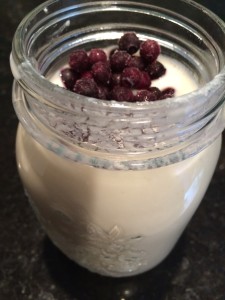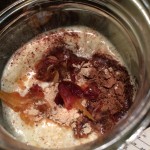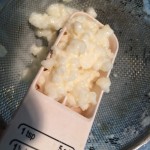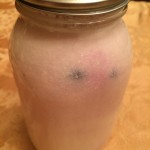 Kefir is by far the most powerful and healing of all fermented foods. Home made kefir made with kefir grains and raw organic pastured milk contain up to 56 types of probiotics. Making your own kefir is quite simple. The most challenging part can be locating the kefir grains to start the process, but there are many online resources available. Some local communities have them, as well. I was fortunate to find some at a local grocery store, which carries both kefir grains and kombucha scobys.
Kefir is by far the most powerful and healing of all fermented foods. Home made kefir made with kefir grains and raw organic pastured milk contain up to 56 types of probiotics. Making your own kefir is quite simple. The most challenging part can be locating the kefir grains to start the process, but there are many online resources available. Some local communities have them, as well. I was fortunate to find some at a local grocery store, which carries both kefir grains and kombucha scobys.
Most healing and illnesses originate in the gut. For this reason, enhancing one’s multitude of probiotics or healthy bacteria is essential for optimal health. There is no comparison between home made kefir and store bought kefir in terms of quantity and type of probiotics, but it can still be beneficial to use store bought kefir. Try and use brands which carry the highest quality ingredients possible, with no added sugar.
For this reason, enhancing one’s multitude of probiotics or healthy bacteria is essential for optimal health. There is no comparison between home made kefir and store bought kefir in terms of quantity and type of probiotics, but it can still be beneficial to use store bought kefir. Try and use brands which carry the highest quality ingredients possible, with no added sugar.
Jordan Rubin described using raw kefir as part of his healing regimen to heal himself from a life threatening case of Crohn’s disease. Rubin states: “I decided to include these HSOs (homeostatic soil organisms) in my daily diet, which also included raw goat’s milk in the form of fermented kefir, different organically grown free-range or grass-fed meats, natural sprouted or sour dough breads made from whole grains which were yeast free, organic fruits and vegetables, raw sauerkraut, and carrot and other vegetable juices-all “live” foods with their beneficial enzymes and microorganisms intact.”
Flavoring Kefir
The secret to home made delicious kefir is the 2nd fermentation. By adding fresh or frozen organic berries to the kefir, mixing and letting sit out for a few more hours, a delicious sweet flavor can be obtained. Otherwise, kefir tends to be somewhat sour to the taste.
Kefir versus Yoghurt
Kefir varies from yoghurt in texture, taste and numbers of probiotics. Home made kefir has between 30 to 56 strains of probiotics, while yogurt contains only 7 to 10. The types of probiotics in kefir assist with inflammation and have been reported to heal many health problems. Probiotics contained in kefir are reported to stay in the gut to promote long term healing from illnesses.
Kefir is a drinkable, more liquid form of fermented milk, compared to yogurt which has a thicker texture and is typically eaten with a spoon.
I have personally found it challenging to make home made raw yogurt, with both success and failure. But, with kefir my experience has been repeated, easy success batch after batch!
While my personal preference is for kefir, high quality yogurt is still considered a health food and many swear by its healing qualities. It is a mainstay of the specific carbohydrate diet, which has brought healing to many suffering from Inflammatory Bowel Disease and Autism.
Pasteurized Yogurt/Kefir
The down side of store bought kefir and yogurt is that the vast majority are pasteurized or heated at high temperatures. This process destroys the good bacteria. Probiotics are then added back to the yogurt/kefir, along with added sugar in most brands. This processing destroys much of the health benefits of these fermented foods.
How much Kefir to Eat
I try and eat 1 cup daily, either mixed with my smoothie or by itself. It is a great quick breakfast on those mornings I am running late and need something quick to grab for my car ride. It is recommended to build up to this amount to see how your body handles all these healthy organisms. Once you know that your body can handle kefir, you can eat as much as you like.
Kefir Recipe
Ingredients:
- 2 cups raw, pastured milk (may use pasteurized grass fed organic whole milk or best quality milk available)
- 1-2 tbsp. kefir grains
- frozen or fresh organic berries for flavoring
- mesh strainer
- quart size glass jar with lid
Kefir Directions:
- Pour 2 cups milk into glass container
- Add kefir grains (ratio should be 1-2 tbsp. grains per 2 cups of milk)
- Cover tightly with lid
- Leave out on counter for 24-36 hours
- Drain grains with strainer over bowl or container (I like to use 4 cup glass measuring cup)
- Use kefir grains to repeat process and make more kefir or if no more is desired store grains. (see below)
- Store kefir in glass container in the refrigerator. It should stay fresh for several weeks, up to a year.
Second Fermentation:
To second ferment kefir, simply add some frozen or fresh berries to kefir. Mix together, close  with lid and leave out on counter for a couple more hours or longer. Then place in refrigerator. The fruit provides food for a second fermentation and also adds sweetness and extra nutrition to the kefir. There are lots of recipes for kefir online and in fermenting cookbooks. You can experiment on own, too. I have added raw cacao, raw honey and chopped dates for a delicious chocolate kefir.
with lid and leave out on counter for a couple more hours or longer. Then place in refrigerator. The fruit provides food for a second fermentation and also adds sweetness and extra nutrition to the kefir. There are lots of recipes for kefir online and in fermenting cookbooks. You can experiment on own, too. I have added raw cacao, raw honey and chopped dates for a delicious chocolate kefir.
Kefir Grain Storage:
When you have enough kefir for the moment, you may store kefir grains in the refrigerator. It is advisable to add 1 cup of whole milk for every tablespoon of kefir grains stored, up to one week. If grains need to be stored longer, then 1 additional cup of milk must be added for every additional week needed. IE for 3 weeks of storage time, use 3 cups of milk for 1 tbsp kefir grain. Kefir grains are live organisms and must have food to survive.
is advisable to add 1 cup of whole milk for every tablespoon of kefir grains stored, up to one week. If grains need to be stored longer, then 1 additional cup of milk must be added for every additional week needed. IE for 3 weeks of storage time, use 3 cups of milk for 1 tbsp kefir grain. Kefir grains are live organisms and must have food to survive.
Notes:
You will know when kefir is done, because it will be thicker than milk, but still drinkable. If kefir separates into liquid whey and kefir, it has fermented too long. Do NOT throw out, but simply shake together, strain grains and continue. It may taste a bit more sour, but it can be remedied with a second fermentation. Also, do NOT rinse kefir grains. Strain and then simply re-use to make more kefir or store with milk in fridge.
Sources for Kefir Grains:
Kefir grains can be easily shared if you know someone who makes their own kefir. Kefir grains grow with each new batch, so that eventually one needs to throw them out. They can be eaten or shared with family and friends. Occasionally local health stores carry kefir grains or may know of sources. Online sources for kefir grains include: www.culturedfoodlife.com and www.torontoadvisors.com/suppliers
Resources for this article:
Fallon, Sally, Nourishing Traditions
Schwenk, Donna, Cultured Food for Life
Rubin, Jordan, Patient Heal Thyself, P. 28
Gottschall, Elaine, Breaking the Vicious Cycle
Written by Michelle, Holistic Health to Go
Kefir: The Queen of Fermented Foods was published on Natural News Blogs on February 19th, 2016.

Pingback: The Trifecta of Fermented Foods, Vital for Health
I am truly delighted to read this weblog posts which consists of lots of
useful facts, thanks for providing these statistics.
Pingback: The Trifecta of Fermented Foods, Vital for Health | Holistic Health to Go